初高中16种英语时态总结专题
- 格式:doc
- 大小:60.50 KB
- 文档页数:14
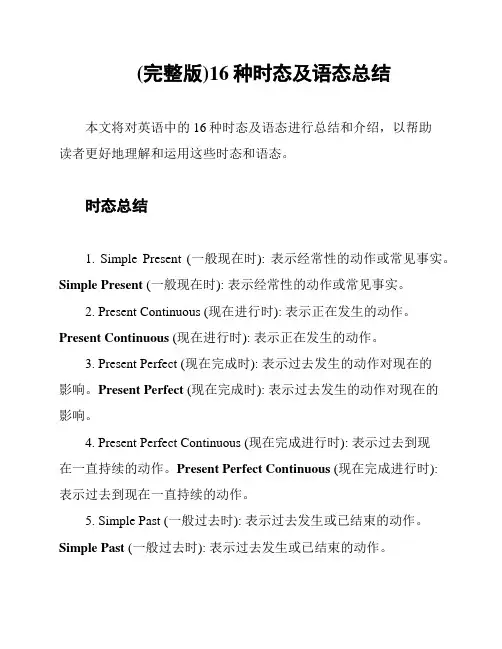
(完整版)16种时态及语态总结本文将对英语中的16种时态及语态进行总结和介绍,以帮助读者更好地理解和运用这些时态和语态。
时态总结1. Simple Present (一般现在时): 表示经常性的动作或常见事实。
Simple Present (一般现在时): 表示经常性的动作或常见事实。
2. Present Continuous (现在进行时): 表示正在发生的动作。
Present Continuous (现在进行时): 表示正在发生的动作。
3. Present Perfect (现在完成时): 表示过去发生的动作对现在的影响。
Present Perfect (现在完成时): 表示过去发生的动作对现在的影响。
4. Present Perfect Continuous (现在完成进行时): 表示过去到现在一直持续的动作。
Present Perfect Continuous (现在完成进行时): 表示过去到现在一直持续的动作。
5. Simple Past (一般过去时): 表示过去发生或已结束的动作。
Simple Past (一般过去时): 表示过去发生或已结束的动作。
6. Past Continuous (过去进行时): 表示过去某个时间段内正在进行的动作。
Past Continuous (过去进行时): 表示过去某个时间段内正在进行的动作。
7. Past Perfect (过去完成时): 表示过去某个时间点之前已经完成的动作。
Past Perfect (过去完成时): 表示过去某个时间点之前已经完成的动作。
8. Past Perfect Continuous (过去完成进行时): 表示过去某个时间点之前一直持续的动作。
Past Perfect Continuous (过去完成进行时): 表示过去某个时间点之前一直持续的动作。
9. Simple Future (一般将来时): 表示将来要发生的动作。
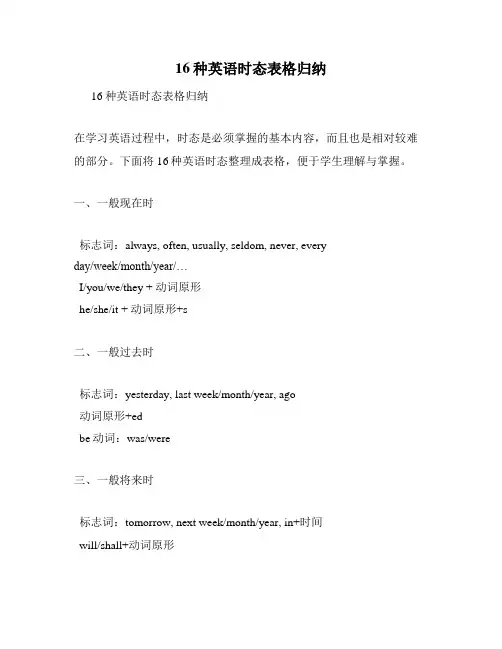
16种英语时态表格归纳16种英语时态表格归纳在学习英语过程中,时态是必须掌握的基本内容,而且也是相对较难的部分。
下面将16种英语时态整理成表格,便于学生理解与掌握。
一、一般现在时标志词:always, often, usually, seldom, never, everyday/week/month/year/…I/you/we/they + 动词原形he/she/it + 动词原形+s二、一般过去时标志词:yesterday, last week/month/year, ago动词原形+edbe动词:was/were三、一般将来时标志词:tomorrow, next week/month/year, in+时间will/shall+动词原形四、现在进行时标志词:now, at the moment, right now, currently am/is/are+现在分词五、过去进行时标志词:at+时间,when, whilewas/were+现在分词六、将来进行时标志词:at+时间will/shall+be+现在分词七、现在完成时标志词:ever, never, already, yet, justhave/has+过去分词八、过去完成时标志词:before, by the timehad+过去分词九、将来完成时标志词:by+时间will/shall+have+过去分词十、一般过去时被动语态标志词:被动语态was/were+过去分词十一、现在完成时被动语态标志词:被动语态have/has+been+过去分词十二、过去完成时被动语态标志词:被动语态had+been+过去分词十三、一般将来时被动语态标志词:被动语态will/shall+be+动词过去分词十四、现在进行时被动语态标志词:被动语态am/is/are+being+过去分词十五、过去进行时被动语态标志词:被动语态was/were+being+过去分词十六、将来进行时被动语态标志词:被动语态will/shall+be+being+过去分词以上是英语16种时态的表格汇总,当然还有很多语法细节需要注意,而且有些时态在实际使用过程中还会存在一些变化。
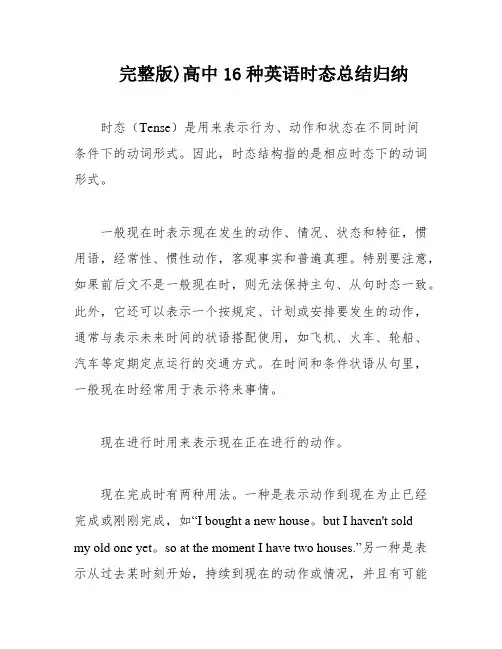
完整版)高中16种英语时态总结归纳时态(Tense)是用来表示行为、动作和状态在不同时间条件下的动词形式。
因此,时态结构指的是相应时态下的动词形式。
一般现在时表示现在发生的动作、情况、状态和特征,惯用语,经常性、惯性动作,客观事实和普遍真理。
特别要注意,如果前后文不是一般现在时,则无法保持主句、从句时态一致。
此外,它还可以表示一个按规定、计划或安排要发生的动作,通常与表示未来时间的状语搭配使用,如飞机、火车、轮船、汽车等定期定点运行的交通方式。
在时间和条件状语从句里,一般现在时经常用于表示将来事情。
现在进行时用来表示现在正在进行的动作。
现在完成时有两种用法。
一种是表示动作到现在为止已经完成或刚刚完成,如“I bought a new house。
but I haven't soldmy old one yet。
so at the moment I have two houses.”另一种是表示从过去某时刻开始,持续到现在的动作或情况,并且有可能会继续延续下去。
这时通常使用延续性动词,时间状语常用since加一个过去的时间点,或for加一段时间,或by加一个现在时间。
4.现在完成进行时 (have been doing)现在完成进行时用来描述一个从过去某一时间开始一直持续到现在的动作或状态,或将继续持续到未来。
例如:我们已经处理这个项目一个多月了,一直在进行中。
5.一般过去时一般过去时用来描述过去某个时间发生的动作或情况,或者过去的惯性动作。
例如:这位老人过去常常坐在公园的长椅上看着别人,一坐就是数个小时。
他以前总是每周看望他的母亲。
在句型中使用 "no sooner than"、"___"、"before"、"r to" 等连接词时,主句要求完成时。
例如:今天之前我从未见过那位教授。
在填空题中,句子中的动作已经持续了一段时间,并且需要进行修理。
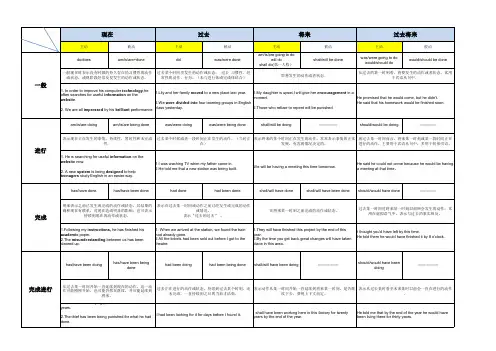
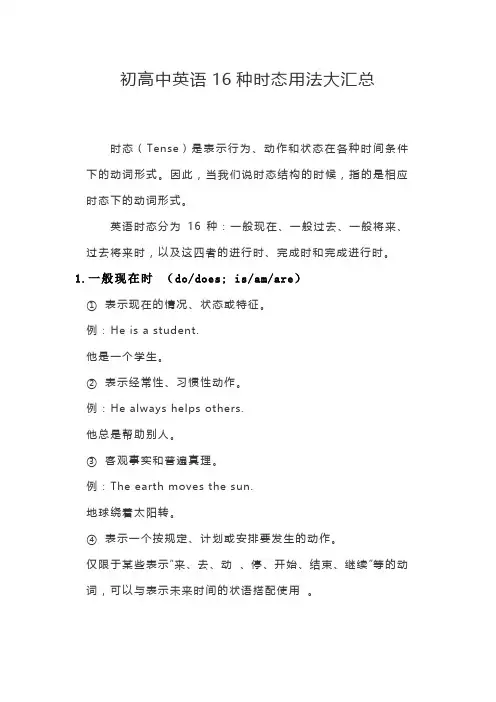
初高中英语16种时态用法大汇总时态(Tense)是表示行为、动作和状态在各种时间条件下的动词形式。
因此,当我们说时态结构的时候,指的是相应时态下的动词形式。
英语时态分为16种:一般现在、一般过去、一般将来、过去将来时,以及这四者的进行时、完成时和完成进行时。
1.一般现在时(do/does; is/am/are)①表示现在的情况、状态或特征。
例:He is a student.他是一个学生。
②表示经常性、习惯性动作。
例:He always helps others.他总是帮助别人。
③客观事实和普遍真理。
例:The earth moves the sun.地球绕着太阳转。
④表示一个按规定、计划或安排要发生的动作。
仅限于某些表示“来、去、动、停、开始、结束、继续”等的动词,可以与表示未来时间的状语搭配使用。
常见的用法是:飞机、火车、轮船、汽车等定期定点运行的交通方式。
例:The next train leaves at 3 o'clock this afternoon.下一趟火车今天下午3点开车。
⑤在时间、条件和让步状语从句中经常用一般现在(有时也用现在完成时)表示将的来事情。
(即:主将从现原则)例:I will call you as soon as I arrive at the airport.我一到机场就会给你打电话。
When you have finished the report, I will have waited for about 3 hours.等你完成这份报告的时候,我就已经等了将近3个小时了。
2. 现在进行时(am/is/are doing)①表示此时此刻正在发生的事情。
例:He is listning to the music now.他现在正在听音乐。
②表示目前一段时间内一直在做的事情,但不一定此时此刻正在做。
例:I am studying computer this term.这个学期我一直在学习计算机。
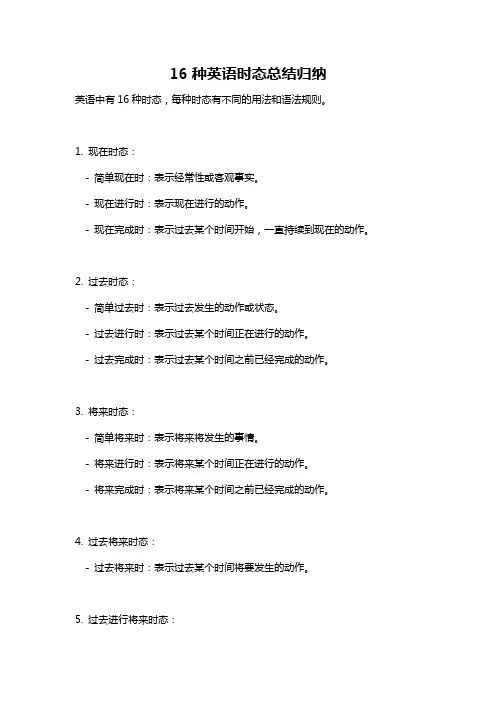
16种英语时态总结归纳英语中有16种时态,每种时态有不同的用法和语法规则。
1. 现在时态:- 简单现在时:表示经常性或客观事实。
- 现在进行时:表示现在进行的动作。
- 现在完成时:表示过去某个时间开始,一直持续到现在的动作。
2. 过去时态:- 简单过去时:表示过去发生的动作或状态。
- 过去进行时:表示过去某个时间正在进行的动作。
- 过去完成时:表示过去某个时间之前已经完成的动作。
3. 将来时态:- 简单将来时:表示将来将发生的事情。
- 将来进行时:表示将来某个时间正在进行的动作。
- 将来完成时:表示将来某个时间之前已经完成的动作。
4. 过去将来时态:- 过去将来时:表示过去某个时间将要发生的动作。
5. 过去进行将来时态:- 过去进行将来时:表示过去某个时间正在进行,将来会继续进行的动作或状态。
6. 过去完成将来时态:- 过去完成将来时:表示过去某个时间之前将会完成的动作。
7. 现在完成进行时:表示过去某个时间开始,一直持续到现在,并可能会继续进行的动作。
8. 现在完成完成时:表示过去某个时间开始,一直持续到现在,并已经完成的动作。
9. 过去完成进行时:表示过去某个时间之前已经开始,一直持续到过去某个时间的动作。
10. 现在完成将来时:表示将来某个时间之前已经开始,一直持续到现在,并将会继续进行的动作。
11. 过去完成将来进行时:表示过去某个时间将要发生的,将会持续到一个将来某个时间的动作。
12. 过去完成将来完成时:表示过去某个时间将会完成的动作。
13. 不定式:表示动作的目的、愿望、命令等。
14. 进行不定式:表示正在进行的不定式动作。
15. 完成不定式:表示已经完成的不定式动作。
16. 进行完成不定式:表示将来要完成的不定式动作。
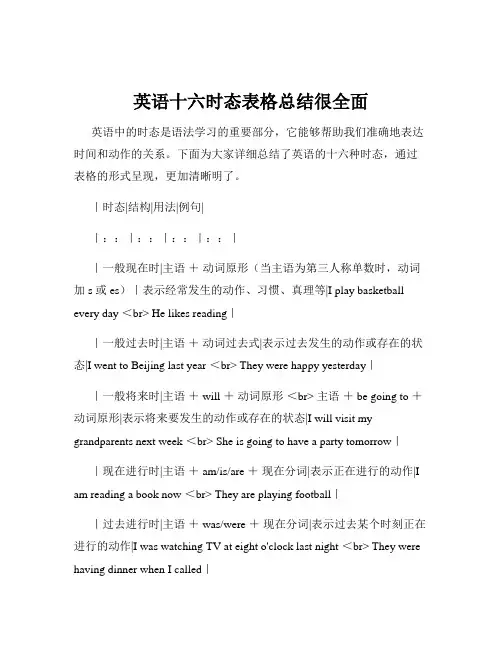
英语十六时态表格总结很全面英语中的时态是语法学习的重要部分,它能够帮助我们准确地表达时间和动作的关系。
下面为大家详细总结了英语的十六种时态,通过表格的形式呈现,更加清晰明了。
|时态|结构|用法|例句||::|::|::|::||一般现在时|主语+动词原形(当主语为第三人称单数时,动词加 s 或 es)|表示经常发生的动作、习惯、真理等|I play basketball every day <br> He likes reading||一般过去时|主语+动词过去式|表示过去发生的动作或存在的状态|I went to Beijing last year <br> They were happy yesterday||一般将来时|主语+ will +动词原形<br> 主语+ be going to +动词原形|表示将来要发生的动作或存在的状态|I will visit my grandparents next week <br> She is going to have a party tomorrow||现在进行时|主语+ am/is/are +现在分词|表示正在进行的动作|I am reading a book now <br> They are playing football||过去进行时|主语+ was/were +现在分词|表示过去某个时刻正在进行的动作|I was watching TV at eight o'clock last night <br> They were having dinner when I called|be +现在分词|表示将来某个时刻正在进行的动作|I will be sleeping at this time tomorrow <br> They are going to be working at nine o'clock tomorrow morning||现在完成时|主语+ have/has +过去分词|表示过去发生的动作对现在造成的影响或结果,或过去的动作一直持续到现在|I have finished my homework <br> He has lived here for ten years||过去完成时|主语+ had +过去分词|表示过去某个时间之前已经完成的动作|I had learned 500 words before I entered this school <br> By the end of last year, she had written three novels||将来完成时|主语+ will have +过去分词<br> 主语+ be going to have +过去分词|表示到将来某个时间为止将会完成的动作|By the time you come back, I will have finished the work <br> They are going to have built the bridge by the end of next month||现在完成进行时|主语+ have/has been +现在分词|表示从过去某时开始一直持续到现在的动作,并且还将继续下去|I have been waiting for you for two hours <br> She has been studying English since 2010||过去完成进行时|主语+ had been +现在分词|表示过去某一时间之前一直在进行的动作|He had been waiting for her for two hours when she arrived <br> They had been working on the project for a week before I joined them|be going to have been +现在分词|表示将来某一时间之前一直持续的动作,并可能继续下去|By the end of next year, I will have been teaching for ten years <br> They are going to have been waiting for an hour by the time the bus arrives||过去将来时|主语+ would +动词原形<br> 主语+ was/were going to +动词原形|表示从过去的某个时间看将要发生的动作|He said he would come the next day <br> I knew she was going to buy a new car||过去将来进行时|主语+ would be +现在分词<br> 主语+was/were going to be +现在分词|表示从过去某时看将来某时正在进行的动作|He said he would be working at this time the next day <br> I thought she was going to be sleeping at nine o'clock||过去将来完成时|主语+ would have +过去分词<br> 主语+was/were going to have +过去分词|表示从过去看将来某时前已经完成的动作|He said he would have finished the work by the end of the month <br> I thought she was going to have bought the dress before her birthday||过去将来完成进行时|主语+ would have been +现在分词<br> 主语+ was/were going to have been +现在分词|表示从过去某时看将来某时之前一直在进行的动作|He said he would have been waiting for her for two hours by six o'clock <br> I thought she was going to have been studying for three hours by then|需要注意的是,时态的掌握需要不断的积累和练习,不能仅仅依靠死记硬背。
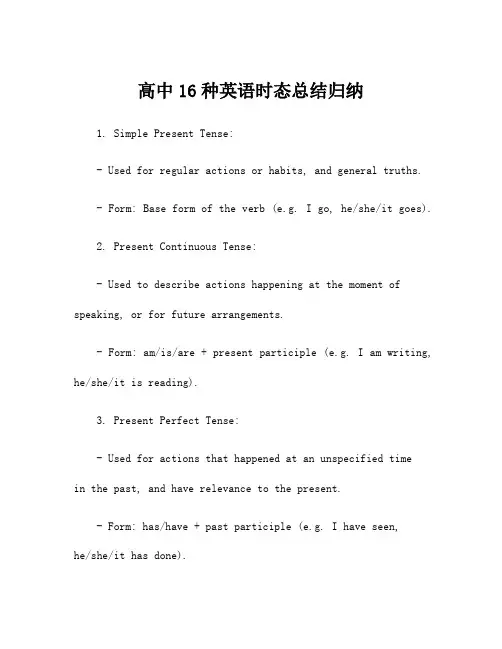
高中16种英语时态总结归纳1. Simple Present Tense:- Used for regular actions or habits, and general truths.- Form: Base form of the verb (e.g. I go, he/she/it goes).2. Present Continuous Tense:- Used to describe actions happening at the moment of speaking, or for future arrangements.- Form: am/is/are + present participle (e.g. I am writing, he/she/it is reading).3. Present Perfect Tense:- Used for actions that happened at an unspecified timein the past, and have relevance to the present.- Form: has/have + past participle (e.g. I have seen,he/she/it has done).4. Present Perfect Continuous Tense:- Used for actions that started in the past and continue into the present, and emphasize duration.- Form: has/have been + present participle (e.g. I have been waiting, he/she/it has been working).5. Simple Past Tense:- Used for actions that started and finished at aspecific time in the past.- Form: Past form of the verb (e.g. I went, he/she/it played).6. Past Continuous Tense:- Used to emphasize the duration of an action in the past, or for two actions happening simultaneously in the past.- Form: was/were + present participle (e.g. I was sleeping, he/she/it was writing).7. Past Perfect Tense:- Used to describe an action that happened before another action in the past.- Form: had + past participle (e.g. I had seen, he/she/it had finished).8. Past Perfect Continuous Tense:- Used to show the duration of an action that happened before another action in the past.- Form: had been + present participle (e.g. I had been waiting, he/she/it had been studying).9. Simple Future Tense:- Used to talk about actions that will happen in the future.- Form: will/shall + base form of the verb (e.g. I will go, he/she/it will eat).10. Future Continuous Tense:- Used to describe actions that will be ongoing at a specific time in the future.- Form: will/shall be + present participle (e.g. I will be waiting, he/she/it will be working).11. Future Perfect Tense:- Used for actions that will be completed before another action in the future.- Form: will have + past participle (e.g. I will have finished, he/she/it will have left).12. Future Perfect Continuous Tense:- Used to emphasize the duration of an action that will be completed before another action in the future.- Form: will have been + present participle (e.g. I will have been waiting, he/she/it will have been studying).13. Present Unreal Conditional:- Used to talk about hypothetical situations in the present or future, expressing results that are unlikely or impossible.- Form: if + simple past, would + base form (e.g. If I were rich, I would travel the world).14. Past Unreal Conditional:- Used to talk about hypothetical situations in the past, expressing results that didn't happen.- Form: if + past perfect, would have + past participle(e.g. If I had studied harder, I would have passed the test).15. Mixed Tenses:- Used to describe actions that happen at the same time but in the past and present or future.- Form: Mix of different tenses.16. Future Time Clauses:- Used to indicate two actions happening in the future, with the main clause in the future and the time clause in the present.- Form: Present tense in the time clause, will/shall or other future tense in main clause (e.g. When I am 25, I will have graduated).。
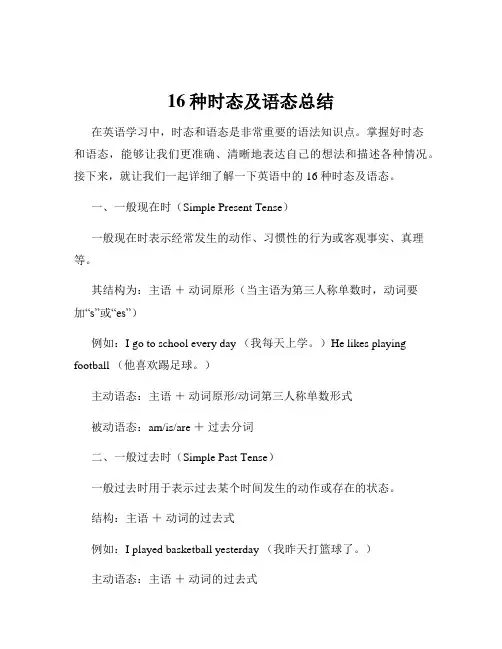
16种时态及语态总结在英语学习中,时态和语态是非常重要的语法知识点。
掌握好时态和语态,能够让我们更准确、清晰地表达自己的想法和描述各种情况。
接下来,就让我们一起详细了解一下英语中的 16 种时态及语态。
一、一般现在时(Simple Present Tense)一般现在时表示经常发生的动作、习惯性的行为或客观事实、真理等。
其结构为:主语+动词原形(当主语为第三人称单数时,动词要加“s”或“es”)例如:I go to school every day (我每天上学。
)He likes playing football (他喜欢踢足球。
)主动语态:主语+动词原形/动词第三人称单数形式被动语态:am/is/are +过去分词二、一般过去时(Simple Past Tense)一般过去时用于表示过去某个时间发生的动作或存在的状态。
结构:主语+动词的过去式例如:I played basketball yesterday (我昨天打篮球了。
)主动语态:主语+动词的过去式被动语态:was/were +过去分词三、一般将来时(Simple Future Tense)一般将来时表示将来要发生的动作或存在的状态。
结构:will +动词原形或者 be going to +动词原形例如:I will visit my grandparents next week (我下周要去看望我的祖父母。
)主动语态:will +动词原形或者 be going to +动词原形被动语态:will be +过去分词或者 be going to be +过去分词四、过去将来时(Past Future Tense)过去将来时主要用于描述过去某个时间点看来将要发生的动作或存在的状态。
结构:would +动词原形或者 was/were going to +动词原形例如:He said he would come the next day (他说他第二天会来。
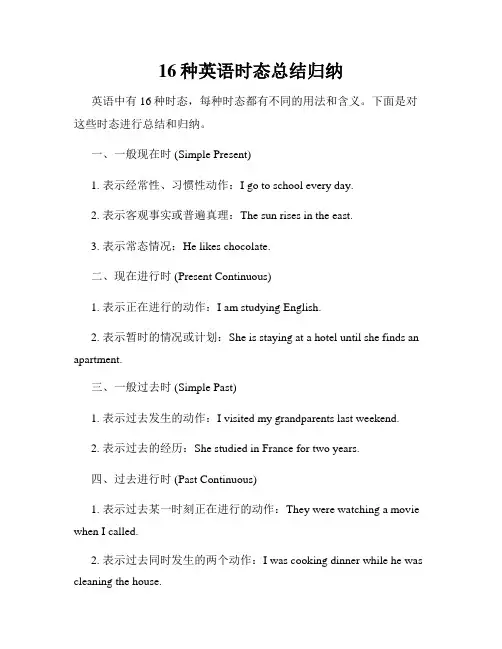
16种英语时态总结归纳英语中有16种时态,每种时态都有不同的用法和含义。
下面是对这些时态进行总结和归纳。
一、一般现在时 (Simple Present)1. 表示经常性、习惯性动作:I go to school every day.2. 表示客观事实或普遍真理:The sun rises in the east.3. 表示常态情况:He likes chocolate.二、现在进行时 (Present Continuous)1. 表示正在进行的动作:I am studying English.2. 表示暂时的情况或计划:She is staying at a hotel until she finds an apartment.三、一般过去时 (Simple Past)1. 表示过去发生的动作:I visited my grandparents last weekend.2. 表示过去的经历:She studied in France for two years.四、过去进行时 (Past Continuous)1. 表示过去某一时刻正在进行的动作:They were watching a movie when I called.2. 表示过去同时发生的两个动作:I was cooking dinner while he was cleaning the house.五、一般将来时 (Simple Future)1. 表示将要发生的动作:I will meet you at the park tomorrow.2. 表示决定或打算:We are going to have a party next weekend.六、将来进行时 (Future Continuous)1. 表示将来某一时刻正在进行的动作:They will be traveling to Europe this time next year.2. 表示持续性的动作:I will be working late tonight.七、现在完成时 (Present Perfect)1. 表示过去发生但与现在有关的动作:I have finished my homework.2. 表示经历或经验:He has traveled to many countries.八、过去完成时 (Past Perfect)1. 表示在过去某一时刻之前已经完成的动作:They had already left when I arrived.2. 表示顺序:She had read the book before watching the movie.九、将来完成时 (Future Perfect)1. 表示将来某一时刻之前完成的动作:I will have finished my project by tomorrow.2. 表示结果:They will have arrived by the time we get there.十、现在完成进行时 (Present Perfect Continuous)1. 表示从过去某一时刻开始一直持续到现在的动作:I have been studying for three hours.2. 表示强调动作的持续性:He has been working all day.十一、过去完成进行时 (Past Perfect Continuous)1. 表示过去某一时刻之前一直持续到过去的动作:She had been waiting for two hours when the bus finally arrived.2. 表示强调动作的持续性:They had been playing tennis all afternoon.十二、将来完成进行时 (Future Perfect Continuous)1. 表示将来某一时刻之前持续进行的动作:I will have been studying for five hours by the time the exam starts.2. 表示强调动作的持续性:They will have been working on the project for a month.十三、虚拟现在时 (Present Unreal)1. 表示与现在事实相反的假设:If I were rich, I would buy a mansion.2. 表示建议或要求:I suggest that he study more.十四、虚拟过去时 (Past Unreal)1. 表示与过去事实相反的假设:If I had studied harder, I would have passed the exam.2. 表示遗憾或后悔:I wish I had bought that dress.十五、虚拟将来时 (Future Unreal)1. 表示与将来事实相反的假设:If I won the lottery, I would travel the world.2. 表示不可能实现的愿望:I wish she would become a famous singer.十六、过去将来时 (Future in the Past)1. 表示过去某一时刻之后将要发生的动作:He said he would call me later.2. 表示过去的计划:I thought we were going to have dinner together.以上是对16种英语时态的总结归纳。
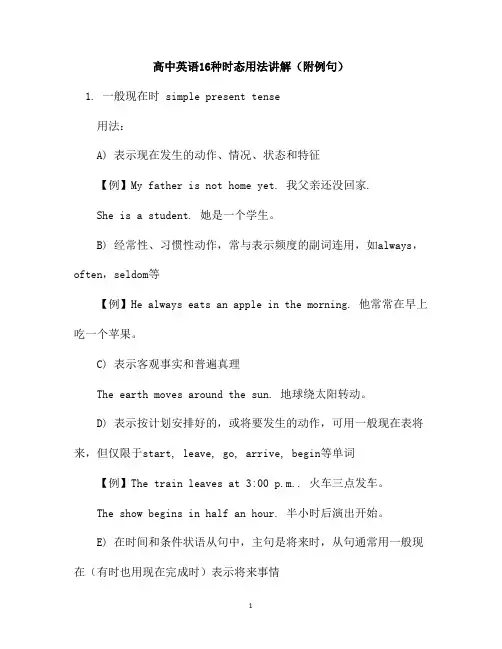
高中英语16种时态用法讲解(附例句)1. 一般现在时 simple present tense用法:A) 表示现在发生的动作、情况、状态和特征【例】My father is not home yet. 我父亲还没回家.She is a student. 她是一个学生。
B) 经常性、习惯性动作,常与表示频度的副词连用,如always,often,seldom等【例】He always eats an apple in the morning. 他常常在早上吃一个苹果。
C) 表示客观事实和普遍真理The earth moves around the sun. 地球绕太阳转动。
D) 表示按计划安排好的,或将要发生的动作,可用一般现在表将来,但仅限于start, leave, go, arrive, begin等单词【例】The train leaves at 3:00 p.m.. 火车三点发车。
The show begins in half an hour. 半小时后演出开始。
E) 在时间和条件状语从句中,主句是将来时,从句通常用一般现在(有时也用现在完成时)表示将来事情【例】I will go to bed when he comes back. 等他回来了我就去睡觉。
If you don't stop the yelling, I will leave right now. 如果你还继续大吼大叫的话,我现在就走。
2. 现在进行时 present progressive tense用法:A) 表示说话时正在进行的动作【例】They are having lunch. 他们在吃饭。
B) 表示现阶段正在进行的动作【例】We are looking for a new house. 我们现在在找新房子。
3. 现在完成时 present perfect tense用法:A) 表示动作到现在为止已经完成或刚刚完成【例】I have just finished my homework. 我刚刚才写完作业。
十六种时态知识点总结一、一般现在时1. 定义:一般现在时用于描述习惯性的动作、事实、真理或普遍性陈述。
2. 结构:主语+动词原形(第三人称单数加-s)+其他。
3. 例句:He goes to school every day.(他每天去上学。
)二、一般过去时1. 定义:一般过去时用于描述过去发生的事情或状态。
2. 结构:主语+动词过去式+其他。
3. 例句:She played basketball yesterday.(她昨天打篮球。
)三、一般将来时1. 定义:一般将来时用于表示将来发生的动作或状态。
2. 结构:主语+will/shall+动词原形+其他。
3. 例句:I will go to the movies tomorrow.(我明天会去看电影。
)四、一般现在进行时1. 定义:一般现在进行时用于描述当前正在进行的动作或状态。
2. 结构:主语+am/is/are+动词-ing+其他。
3. 例句:They are watching TV now.(他们现在正在看电视。
)五、一般过去进行时1. 定义:一般过去进行时用于描述过去某个时间点正在进行的动作或状态。
2. 结构:主语+was/were+动词-ing+其他。
3. 例句:She was studying at 8 o'clock last night.(昨晚八点她在学习。
)六、一般将来进行时1. 定义:一般将来进行时用于表示将来某个时间点正在进行的动作或状态。
2. 结构:主语+will be+动词-ing+其他。
3. 例句:They will be playing soccer at 3 o'clock tomorrow.(明天三点他们将在踢足球。
)七、一般现在完成时1. 定义:一般现在完成时用于描述过去发生的动作对当前的影响或结果。
2. 结构:主语+have/has+动词过去分词+其他。
3. 例句:She has finished her homework.(她已经完成了她的作业。
中考英语必会时态1.一般现在时(do/does; is/am/are)①表示现在的情况、状态或特征。
例:He is a student.他是一个学生。
②表示经常性、习惯性动作。
例:He always helps others.他总是帮助别人。
③客观事实和普遍真理。
例:The earth moves the sun.地球绕着太阳转。
④表示一个按规定、计划或安排要发生的动作。
仅限于某些表示“来、去、动、停、开始、结束、继续”等的动词,可以与表示未来时间的状语搭配使用。
常见的用法是:飞机、火车、轮船、汽车等定期定点运行的交通方式。
例:The next train leaves at 3 o'clock this afternoon.下一趟火车今天下午3点开车。
⑤在时间、条件和让步状语从句中经常用一般现在(有时也用现在完成时)表示将的来事情。
(即:主将从现原则)例:I will call you as soon as I arrive at the airport.我一到机场就会给你打电话。
2.现在进行时(am/is/are doing)①表示此时此刻正在发生的事情。
例:He is listning to the music now.他现在正在听音乐。
②表示目前一段时间内一直在做的事情,但不一定此时此刻正在做。
例:I am studying computer this term.这个学期我一直在学习计算机。
③现在进行时可以表示将来的含义。
瞬时动词的进行一定表将来。
例:I am leaving.我要离开了。
持续动词的进行只有有将来的时间状语或有将来语境中才表将来。
例:I am travelling next month.下个月我要去旅行。
④现在进行时与频度副词连用,表示说话者或褒义或贬义的感情色彩。
例:He is always helping others.他总是帮助别人。
(褒义)3.现在完成时(have/has done)①表示动作到现在为止已经完成或刚刚完成,强调对现在产生的影响。
十六个英语时态表格一:英语中的16种时态总结表十六个英语时态表格二:一张图看懂英语的16个时态一张图看懂英语的16个时态英语时态的系统学习和复习英语与汉语最大之不同就是英语具有时态的语法特点,而汉语则无此项语法内容。
此种区别也恐是广大中国学生学习英语的最大障碍之一。
莱曼英语始终认为,任何一个庞杂,混乱,使人感到困惑的事物,只要找到其内在的规律,就会较为容易地驾驭和掌握它。
英语的时态也不例外。
事实上,人人都懂得这个道理。
但是,发现一个事物的内在规律就不是嘴上说说那么容易了。
一.时态概论所谓的英语时态就是动作发生的时间不同,要用不同的动词形式来表达。
因而,英语时态的驾驭和掌握必须以动作发生的时间为根本,进行判断,从而来进行时态的选择。
英语中,常用的时态共计十种。
根据现行的学校教材安排,英语时态被分成下列三个阶段小学四种初中四种(兼顾复习小学所学的四种)高中二种重难点在于各种时态之间的区别,综合运用以及动词形式的记忆。
二.时态分类英语时态按下列名称分类为现在时态过去时态一般现在时一般过去时现在将来时过去将来时现在进行时过去进行时现在完成时过去完成时现在将来进行时现在完成进行时以上各时态平起平坐,无任何顺序排列而言。
也即,它们是同等的重要和常用,不应厚此薄彼。
三.学习方法莱曼英语在多年的教学实践中,一直奉行方法领先的教学原则。
在教授英语时态时也不例外。
只有这样,才能使学生概念清晰,才能使学生在学完时态以后,娴熟地将其转化为能力。
莱曼英语根据英语时态的内在规律,推出英语时态的“五点论”学习方法含义每一种时态独有反映其内在规律的含义。
中文线索每一种英语时态都会有相应的中文时间定位。
构成每一种时态都有其独特的构成,或被称为时态句型。
助动词时态不同,助动词也就不同。
帮助构成问句和否定句。
时态例句通过例句,掌控不同的时态,使其娴熟起来,区别于其他时态。
四.各时态例句展示一般现在时I always swim in the afternoon.It is usually sunny.He always swims in the afternoon.He feels very relaxed.现在将来时I will swim tomorrow afternoon.I am not going to have any classes.He will swim tomorrow afternoon.He is going to have a swimming test.现在进行时I am swimming in the gym with my classmates now.I want to improve my swimming skill.He is swimming in the gym with his classmates now.He likes swimming very much.现在完成时I have already swum for nearly an hour. I enjoyed myself very much.He has already swum for nearly an hour. He felt a little bit tired.一般过去时I swam yesterday afternoon.I didn"t do my homework.He swam yesterday afternoon.He had nothing to do at that time.过去将来时I told you just now that I would swim in the gym.You may find me there.He said that he he would swim in the gym.And he asked us to meet him there.过去进行时She asked me if I was swimming in the lake.I said "yes".He told us on the phone that he was swimming in the lake.And he wanted to continue.过去完成时I had already swum for half an hour when he came to the swimming pool.Then he joined us.He told me that he had already swum for more than an hour.And he had never relaxed like that.现在将来进行时I will be swimming with my classmates tomorrow afternoon.I can"t go to see my grandparents.He will be swimming in the sea of Hawaii this time next year.I hope he will have a good time there.10.现在完成进行时I have been swimming here for thirty minutes.And more people are coming to join us.He has been swimming here for an hour.It seems that he will be in the water for another hour.以上是莱曼英语为大家粗略总结和对比了一下英语中常见的时态例句。
16种英语时态总结归纳第1篇1.概念:在将来某一时刻之前开始的动作或状态2.时间状语:by the time of; by the end of + 时间短语(将来);by the time +从句(将来)3.基本结构:主语 + be going to/will/shall + have + (过去分词) + 其它4例句:By the time you get back, great changes will have taken place in thisarea.到你回来的时候,就将发生巨大的变化。
16种英语时态总结归纳第2篇概念:经常、反复发生的动作或行为及现在的某种状况。
时间状语: always, usually, often, sometimes, every week (day, year, month…), once a week, on Sundays基本结构:① be 动词;xxx动词否定形式:① am/is/are+not;②谓语动词若为实义动词,A.主语不是三单式,则don't+动词原形B.主语为三单式,则 doesn't+动词原形。
一般疑问句:①把 be动词放于句首;②谓语动词若为实义动词,A.主语不是三单式,用助动词Do+主语+动词原形B.主语为三单式,则Does+主语+动词原形Helen ________ a good student.(be)Helen ________ fishing very much.(like)Helen’s friends usually ________ to school by bike.(go)16种英语时态总结归纳第3篇1.概念:表示现阶段或说话时正在进行的动作及行为。
2.时间状语:Now, at this time, days, etc. look, listen3.基本结构:主语 + be + doing + 其它4.否定形式:主语 + be + not +doing + 其它5.一般疑问句:把be动词放于句首。
16种时态汇总表时态是指动词在不同时间下所表示的形式和意义。
汇总了所有可能的时态,应该总共有16种时态。
下面是这16种时态的汇总表:1. 一般现在时(Simple Present)结构:主语 + 动词原形用法:表示经常发生的动作、事实或真理。
例句:She runs every morning.2. 一般过去时(Simple Past)结构:主语 + 动词过去式用法:表示过去某个时间发生的动作或状态。
例句:He studied in London last year.3. 一般将来时(Simple Future)结构:主语 + will + 动词原形用法:表示将来发生的动作或状态。
例句:I will meet him tomorrow.4. 现在进行时(Present Continuous)结构:主语 + am/is/are + 动词-ing形式用法:表示现在正在进行或发生的动作。
例句:They are watching TV right now.5. 过去进行时(Past Continuous)结构:主语 + was/were + 动词-ing形式用法:表示过去某个时间正在进行的动作。
例句:He was reading a book when I called him.6. 将来进行时(Future Continuous)结构:主语 + will be + 动词-ing形式用法:表示将来某个时间正在进行的动作。
例句:They will be playing tennis this time tomorrow.7. 现在完成时(Present Perfect)结构:主语 + has/have + 过去分词用法:表示过去发生的动作对现在造成的影响或结果。
例句:I have finished my homework.8. 过去完成时(Past Perfect)结构:主语 + had + 过去分词用法:表示过去某个时间发生的动作在过去另一个时间之前完成或发生。
【整理】英语16种时态表一、一般现在时一般现在时表示经常发生或习惯性的动作、状态或真理。
其结构为:主语 + 动词原形(第三人称单数加s/es)。
例句:He goes to school bike every day.(他每天骑自行车上学。
)二、一般过去时一般过去时表示过去某个时间发生的动作或存在的状态。
其结构为:主语 + 动词过去式。
例句:I visited the Great Wall last year.(去年我参观了长城。
)三、一般将来时一般将来时表示将来某个时间会发生的动作或存在的状态。
其结构为:will + 动词原形。
例句:She will graduate from college next year.(她明年将大学毕业。
)四、现在进行时现在进行时表示正在进行的动作或状态。
其结构为:主语 + be动词(am/is/are) + 现在分词。
例句:They are watching a movie in the cinema.(他们正在电影院看电影。
)五、过去进行时过去进行时表示在过去某个时间正在进行的动作或状态。
其结构为:主语 + was/were + 现在分词。
例句:She was reading a book when I called her.(我给她打电话时,她正在看书。
)六、将来进行时将来进行时表示将来某个时间正在进行的动作或状态。
其结构为:will be + 现在分词。
例句:In two hours, we will be sitting in the classroom.(两小时后,我们将坐在教室里。
)七、现在完成时现在完成时表示过去发生的动作对现在造成的影响或结果,常与时间状语since, for, already, yet等连用。
其结构为:主语 +have/has + 过去分词。
例句:She has already finished her homework.(她已经完成了她的家庭作业。
E) 表示一个按规定、计划或安排要发生的动作,(仅限于某些表示“来、去、动、停、开始、结束、继续”等的动词)可以与表示未来时间的状语搭配使用。
常见的用法是:飞机、火车、轮船、汽车等定期定点运行的交通方式。
例:The next train leaves at 3 o'clock this afternoon.(下一趟火车今天下午3点开车。
)How often does this shuttle bus run? (这班车多久一趟?)F) 在时间和条件状语从句里经常用一般现在(有时也用现在完成时)表示将来事情。
例:When you have finished the report, I will have waited for about 3 hours.(等你完成这份报告的时候,我就已经等了将近3个小时了。
)2. 现在进行时(be doing)用法:现在正在进行的动作。
3. 现在完成时(have done)用法:A) 表示动作到现在为止已经完成或刚刚完成。
例:I bought a new house, but I _________ my old one yet, so at the moment I have two houses.A) didn't sell B) sold C) haven't sold D) would sell答案是C) haven't sold。
B) 表示从过去某时刻开始,持续到现在的动作或情况,并且有可能会继续延续下去。
此时经常用延续性动词。
时间状语常用since加一个过去的时间点,或for 加一段时间,或by加一个现在时间。
例:Great as Newton was, many of his ideas ___________ today and are being modified by the work of scientists of our time.A) are to challenge C) have been challengedB) may be challenged D) are challenging全句的意思是:“虽然牛顿是个伟大的人物,但他的许多见解直到今天还在受到挑战,并且被现代科学家的工作所修正。
”challenge是及物动词,在本句中应当是被动语态;其动作延续到今天,所以要用现在完成时态。
可见答案是C) have been challenged。
A) are to challenge和D) are challenging都是主动语态,不可能是答案。
B) may be challenged虽然是被动语态,但意思与全句内容不合,所以不对。
C) 表示发生在过去,但对现在仍有影响的动作或情况。
通常用点动词,如:arrive, begin, find, give, lose等。
例:John has broken his left leg.(约翰摔断了左腿。
)注意事项A) 现在完成时是联系过去和现在的纽带。
现在完成时和过去时的区别在于:现在完成时强调动作的动态,或受动态的影响,是动态的结果,对现在有影响;过去时只表示过去的某个具体时间里发生的动作,与现在没有联系。
例:He worked in that hospital for 8 years.(他曾经在那家医院工作了8年。
这只是讲述一个过去的事实,他现在已经不在那家医院了。
)He has worked in that hospital for 8 years.(他已经在那家医院里工作了8年。
表示他从过去开始工作,一直工作到现在,现在仍在那家医院工作。
)B) 因为含有for加一段时间或since加一个时间点这样的时间状语的完成时,有动态和延续性的特点,所以不能使用终端动词或瞬间动词。
例:My sister has been married for 5 years.(过去分词做表语表示状态,可以延续)My sister has married. Don't disturb her.(终端动词)C) 在"this is the first/ second/ third……time that……"句型里要求用完成时。
例:This is the second time that the products of our company have been shown in the International Exhibition.(这是我公司产品第二次参加国际展览会。
)D) 句型"It is/ has been……since"所使用的两种时态都正确。
例:It is/ has been 10 years since I last saw him.(从我上次见到他以来已经10年了。
)E) 在"no sooner than"、"hardly/ scarcely ……when"、"before"、"prior to"等句型中,主句要求完成时。
例:I haven't met that professor prior to today.(以前我从未见过那位教授。
)4. 现在完成进行时(have been doing)用法:表示某一动作开始于过去某一时间,延续或重复地出现至今,或将继续延续至将来。
例:We have been working on this project for over a month now.(到目前为止,我们一直在处理那个项目,已经花了一个多月时间了。
)注意事项:与现在完成时相比,现在完成进行时更强调:在从过去到现在的时间里,动作或状态一直持续或一直反复出现。
例:It seems oil ___________ from this pipe for some time. We'll have to take the machine apart to put it right.A) had leaked B) is leakingC) leaked D) has been leaking从本题上下文看,这两个句子的意思是:“看来,这个管道漏油已有一段时间了,我们将不得不拆卸机器排除故障。
”第二句表示将要采取的措施。
第一句动作发生在第二句之前,并且延续到现在为止仍在继续。
因此,空格中需用现在完成时或现在完成进行时。
D) has been leaking是现在完成进行时,因此是本题的答案。
有11%的考生误选了B) is leaking。
由于本句有时间状语for some time,表示谓语动作延续,谓语不能用现在进行时,必须用和完成时有关的时态。
有些考生误选了C) leaked或A) had leaked。
是因为他们没有注意到本题第二句是一般将来时,所以第一句的谓语不能用过去时或过去完成时。
5. 一般过去时用法:A) 表示过去某个时间发生的动作或情况。
B) 表示过去习惯性动作。
特别是由would/ used to do表达的句型,本身表示的就是过去时。
例:The old man would sit on a bench in the quiet park and look at others for hours without doing anything or talking to anybody.(老人过去常常坐在宁静的公园里的一条长椅上,看着其他的人,一坐就是数个小时,什么也不干,也不和任何人交谈。
)He used to visit his mother once a week.(他以前总是每周看望一次他的母亲。
)C) 有时可代替一般现在时,表达一种婉转、客气、礼貌、商量的语气。
例:I wanted to ask you if I could borrow your car?(我想向您借车用一用,可以吗?)Would you mind my sitting here?(您介意我坐在这里吗?)注意事项:A) 注意时间状语的搭配。
一般过去时的时间状语应该是表示过去某个时间的词或词组,如:yesterday, last month, in 1999, two days ago等,绝对不可与recently, in the past 10 years, this month等连用,因为这样的时间状语都与现在有关系,应该用现在完成时或一般现在时。
B) used to do的否定形式和疑问形式很特别:你怎么写都正确。
以否定形式为例:used not to do, didn't used to do, didn't use to do都对。
Used to do经常与be used to doing sth/ sth结构进行对比。
前者表示"过去常常或过去曾经",要求加动词原形;后者表示"习惯于",要求加名词或动名词。
6. 过去完成时(had done)用法:表示在过去的某个时间或动作以前已经发生的动作或已经存在的状态。
就是我们常说的:表示"过去的过去的动作或状态"。
Until then, his family _________ from him for six months.A) didn't hear C) hasn't heard B) hasn't been hearing D) hadn't heard全句的意思是:“到那时为止,他家里已经有六个月没得到他的消息了。
”由此可以看出,谓语动词的动作延续到过去的某一时刻才完成,因此谓语要用过去完成时。
答案是D)。
其它选项中:A) didn't hear,因为一般过去时只表示过去发生的事情或存在的状态,所以不能与时间状语for six months连用。
B) hasn't been hearing,现在完成进行时表示过去某时刻继续到现在或现在还在进行的动作,与题意不符。
C) hasn't heard,现在完成时表示从过去某一时刻到现在为止发生的动作。
而题中的then只表示过去的某一时刻,不能表示现在时间。
注意事项:“过去的过去”这种逻辑关系常通过上下文体现出来,而不一定受某个时间状语的限制。
例:There had been some one in our room just now, because I noticed a burning cigarette end on the floor when we opened the front door.(刚才有人在我们的房间里,因为我们打开前门进来时,我注意到地板上有一支仍在燃烧的香烟。